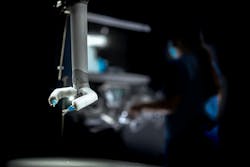Remote RAS system tested aboard the International Space Station
SpaceMIRA, developed by Virtual Incision and researchers at the University of Nebraska, is a compact, lightweight surgical robot sent to the International Space Station (ISS) on a SpaceX Falcon 9 rocket from Cape Canaveral, Florida, in January. From Lincoln, Nebraska, 250 miles below the ISS orbit, six surgeons took turns performing remote testing of the unit by manipulating and cutting a rubber band type material that simulated actual tissue.
SpaceMIRA is a specially designed space-focused iteration of Virtual Incision’s MIRA, a miniaturized robotic-assisted surgery (miniRAS) system commercially available in the United States. Similar to MIRA, its design aims to offer the capabilities of robotic-assisted surgery in a compact and convenient form factor that make it easier to transport and store the device. The modifications of spaceMIRA enabled pre-programmed and long-distance remote surgery capabilities for the experiment on the ISS.
Virtual Incision worked with maxon during the design of both the terrestrial version of MIRA and spaceMIRA. The RAS system incorporates an articulating camera. MIRA and spaceMIRA gain strength in a small size by placing maxon’s motors inside the arms of the minibot. This structure allows the device to tackle a multi-quadrant procedure like colon resection across a range of patient types. The rigid, non-snake-like arms with internally mounted motors deliver the required strength to perform the surgeries while enabling triangulation of the camera and instruments.
The maxon components had to meet a number of specifications due to the high speeds and torques required. In addition to maxon’s complete line of motors and accessories, the company was able to create subassemblies specifically for MIRA. Maxon’s team of engineers were helpful from conception and design to manufacturing of spaceMIRA’s subsystem. Virtual Incision developed all of the accompanying hardware, firmware and software in-house to optimize miniaturization and device performance characteristics.
RAS systems offer multiple benefits to patients, including fewer site infections, less pain, less blood loss, smaller scars, shorter hospital stays and quicker recoveries. The test procedure on the ISS supports the feasibility of long-distance surgeries. MIRA is designed to be easy to clean and sterilize between uses and does not need to be draped. Ultimately, MIRA offers strength for its size and high output force, and it is designed to enable quick setup in any operating room.

